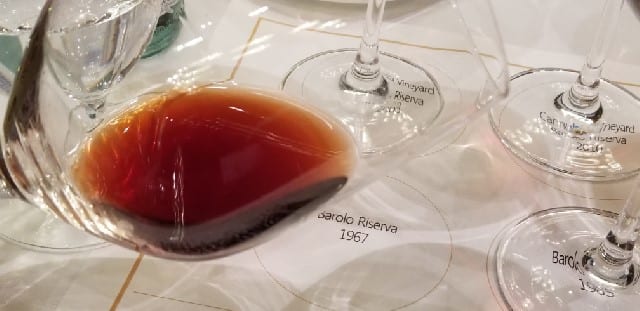
24 May Giacomo Borgogno – The Original Barolo
This story originally appeared in the Napa Valley Register.
Barolo. Just saying the name sounds important. It sounds regal. It sounds strong. When I lived in the Piemonte area in Italy shortly after college, I knew very little, if anything, about wine. But on the table at every meal, I was drinking Dolcetto and Barbera on a daily basis. It was on special occasions that my friends would pull out a bottle of Barolo. I did not have the vocabulary to describe wine. But I knew that this was a special wine.
At Pebble Beach Food and Wine, a panel of sommeliers lead a discussion of Barolo as we sat down for a tasting of the Giacomo Borgogno wines from 1967 to 2010. Founded in 1761, Giacomo Borgogno is the father of Barolo, the original Barolo producer. He was the first to put the local wine into a bottle and commercialize it, beginning the legacy. The Borgogno family managed the estate for 247 years until 2008 when they sold it to the Farinetti family and a new evolution for the winery began.
Barolo has always been a classic wine, considered one of the best. The name implies a big, bold wine, but in the glass, the lack of a deep color contradicted this.
Barolo was a wine of tradition but in the 1980s that changed. The Barolo Boys, a group of young winemakers, started to introduce new techniques drawn from France. They were seen as wine revolutionaries and innovators. They produced wines that required shorter aging time, wines that had more color. They used more barrique.
They were focused on producing Barolo in a style that garnered more scores and had a taste profile in line with international standards set by Robert Parker. Barolo’s became the big wines they were thought to be.
However, in 2008, when the Farinetti family purchased Giacomo Borgogno, they turned to the past. They focused on a more traditional style, a style many believe Barolo should taste like.
Master Sommelier Gillian Balance explained that “Nebbiolo is never going to be soft and never should be inky. The tension, the tannin, the acid of Nebbiolo is what is the driving force of Barolo.” She continued, “it is a wine that screams at you in a beautiful way.”
In the past, Barolo was made in a style that was impenetrable. It was a wine that could not be drunk in its youth, rather it was given as gifts for generations to come. One of the ambitions of the Barolo Boys and other producers in 1980s and 1990s was to make Barolo friendlier and drinkable. Today, we have arrived at a happy medium between the two. The wine is still tannic and still high in acidity but not so much so that you cannot drink it.
Barolo producers, who share a wine culture is similar to Burgundy, focus on the vineyard first and the grape second. They are wines that express a place in the world. Wine Expert David lynch describes Barolo as “the most beguilingly aromatic wine in the world.”
Barolo is not designed to be drunk within one year of release. In fact, Barolos are not released for three years and then need at least five more years before drinking. These are wines that want to be paired with food, and the most logical of pairings is truffles. But beyond truffles, think about texture when pairing Barolo and food. As wine writer Kelli White explained, Barolo’s are “wines of transparency and elegance.” With high tannins in the wines, consider higher fat dishes as the fat binds to the tannins.
Giacomo Borgogno is a certified organic winery, on its way to biodynamic certification. As I put my nose in the glass, I could feel the wine’s importance. No matter how much one knows about wine, it is obvious that Barolo is a special wine.
A few highlights from the tasting:
Giacomo Borgogno Barolo Riserva 1967 – More than 50 years old and this wine still has great acidity. The aromatics are persistent with fresh notes of spices and herbs and the wine has a long finish.
Giacomo Borgogno Barolo Riserva 1985 – This wine has all the classic Barolo aromatics of tomato, lavender and dried flowers.
Both the 1967 and 1985 are wines that were “well-built,” as described by David Lynch. They are wines that are the epitome of structure and showing beautifully decades later.
Giacomo Borgogno Liste Vineyard Barolo Reserva 2010 – 2010 was a great vintage and while this wine is still young, it has structure, intensity and elegance.
Giacomo Borgogno Cannubi Vineyard Barolo Riserva 2008– With a gorgeous bouquet of blueberries, plum, dried flowers, white pepper and a hint of eucalyptus, this wine is graceful and elegant and drinking well now
Read the original story in the Napa Valley Register.
Discover more from Please The Palate
Subscribe to get the latest posts sent to your email.





